A Coupled SWAT-LSTM Approach for Climate-Driven Runoff Dynamics in a Snow- and Ice-Fed Arid Basin
Abstract
1. Introduction
2. Materials and Methods
2.1. Overview of the Study Area
2.2. Data Sources and Processing
2.2.1. Data Sources
2.2.2. Glacier Data Processing
2.3. Modeling Framework and Evaluation Methods
2.3.1. SWAT Model Description
2.3.2. LSTM Model Description
2.3.3. SWAT-LSTM Coupling Mechanism
2.3.4. Model Evaluation Metrics
2.4. CMIP6 Data Processing
2.4.1. Downscaling and Bias Correction
2.4.2. Climate Model Performance Evaluation
3. Results and Discussion
3.1. Model Construction and Performance Analysis
3.1.1. SWAT Model Construction
3.1.2. SWAT-LSTM Input Parameter Characteristics
3.1.3. Runoff Simulation Based on the SWAT and SWAT-LSTM
3.2. Comparison Analysis of Actual Runoff and Natural Runoff Restoration After Reservoir Construction
3.3. Verification of Glacier Area Dynamics and Runoff Hydrological Response Mechanisms
3.3.1. Validation and Analysis of Glacier Area Dynamics
3.3.2. Validation of Glacier–Runoff Hydrological Response
3.4. CMIP6 Model Simulations of Climate Change in the Study Area CMIP6 Models Simulate Climate Change in the Study Area
3.4.1. Downscaling and Bias Correction Results
3.4.2. Future Climate Change
3.5. Annual Runoff Variations Under Future Climate Change Scenarios Based on SWAT-LSTM
3.6. Limitations and Future Research Directions
4. Conclusions
Author Contributions
Funding
Institutional Review Board Statement
Informed Consent Statement
Data Availability Statement
Conflicts of Interest
References
- Apsīte, E.; Bakute, A.; Elferts, D.; Kurpniece, L.; Pallo, I. Climate Change Impacts on River Runoff in Latvia. Clim. Res. 2011, 48, 57–71. [Google Scholar] [CrossRef]
- Landman, W. Climate Change 2007: The Physical Science Basis. S. Afr. Geogr. J. 2010, 92, 86–87. [Google Scholar] [CrossRef]
- Intergovernmental Panel on Climate Change (Ed.) Climate Change 2013—The Physical Science Basis: Working Group I Contribution to the Fifth Assessment Report of the Intergovernmental Panel on Climate Change, 1st ed.; Cambridge University Press: Cambridge, UK, 2014; ISBN 978-1-107-05799-9. [Google Scholar]
- Kasiviswanathan, K.S.; He, J.; Sudheer, K.P.; Tay, J.-H. Potential Application of Wavelet Neural Network Ensemble to Forecast Streamflow for Flood Management. J. Hydrol. 2016, 536, 161–173. [Google Scholar] [CrossRef]
- Chen, X.; Wang, S.; Gao, H.; Huang, J.; Shen, C.; Li, Q.; Qi, H.; Zheng, L.; Liu, M. Comparison of Deep Learning Models and a Typical Process-Based Model in Glacio-Hydrology Simulation. J. Hydrol. 2022, 615, 128562. [Google Scholar] [CrossRef]
- Fatichi, S.; Vivoni, E.R.; Ogden, F.L.; Ivanov, V.Y.; Mirus, B.; Gochis, D.; Downer, C.W.; Camporese, M.; Davison, J.H.; Ebel, B.; et al. An Overview of Current Applications, Challenges, and Future Trends in Distributed Process-Based Models in Hydrology. J. Hydrol. 2016, 537, 45–60. [Google Scholar] [CrossRef]
- Arnold, J.G.; Srinivasan, R.; Muttiah, R.S.; Williams, J.R. LARGE AREA HYDROLOGIC MODELING AND ASSESSMENT PART I: MODEL DEVELOPMENT. J. Am. Water Resour. Assoc. 1998, 34, 73–89. [Google Scholar] [CrossRef]
- Tan, M.L.; Gassman, P.W.; Yang, X.; Haywood, J. A Review of SWAT Applications, Performance and Future Needs for Simulation of Hydro-Climatic Extremes. Adv. Water Resour. 2020, 143, 103662. [Google Scholar] [CrossRef]
- Tokar, A.S.; Markus, M. Precipitation-Runoff Modeling Using Artificial Neural Networks and Conceptual Models. J. Hydrol. Eng. 2000, 5, 156–161. [Google Scholar] [CrossRef]
- Humphrey, G.B.; Gibbs, M.S.; Dandy, G.C.; Maier, H.R. A Hybrid Approach to Monthly Streamflow Forecasting: Integrating Hydrological Model Outputs into a Bayesian Artificial Neural Network. J. Hydrol. 2016, 540, 623–640. [Google Scholar] [CrossRef]
- De Lavenne, A.; Loree, T.; Squividant, H.; Cudennec, C. The transfR Toolbox for Transferring Observed Streamflow Series to Ungauged Basins Based on Their Hydrogeomorphology. Environ. Model. Softw. 2023, 159, 105562. [Google Scholar] [CrossRef]
- Noori, N.; Kalin, L. Coupling SWAT and ANN Models for Enhanced Daily Streamflow Prediction. J. Hydrol. 2016, 533, 141–151. [Google Scholar] [CrossRef]
- Qi, J.; Zhang, X.; Yang, Q.; Srinivasan, R.; Arnold, J.G.; Li, J.; Waldholf, S.T.; Cole, J. SWAT Ungauged: Water Quality Modeling in the Upper Mississippi River Basin. J. Hydrol. 2020, 584, 124601. [Google Scholar] [CrossRef]
- Chen, S.; Huang, J.; Huang, J.-C. Improving Daily Streamflow Simulations for Data-Scarce Watersheds Using the Coupled SWAT-LSTM Approach. J. Hydrol. 2023, 622, 129734. [Google Scholar] [CrossRef]
- Caro, A.; Condom, T.; Rabatel, A.; Champollion, N.; García, N.; Saavedra, F. Hydrological Response of Andean Catchments to Recent Glacier Mass Loss. Cryosphere 2024, 18, 2487–2507. [Google Scholar] [CrossRef]
- Sanjay Potdar, A.; Kirstetter, P.-E.; Woods, D.; Saharia, M. Towards Predicting Flood Event Peak Discharge in Ungauged Basins by Learning Universal Hydrological Behaviors with Machine Learning. J. Hydrometeorol. 2021, 22, 2971–2982. [Google Scholar] [CrossRef]
- Ficklin, D.L.; Stewart, I.T.; Maurer, E.P. Climate Change Impacts on Streamflow and Subbasin-Scale Hydrology in the Upper Colorado River Basin. PLoS ONE 2013, 8, e71297. [Google Scholar] [CrossRef]
- Khodjiev, A. Impact Assessment of Climate Change on Water Resources of the Amu Darya River Basin. E3S Web Conf. 2023, 376, 02010. [Google Scholar] [CrossRef]
- Homa, M.G.; Mengistu Tsidu, G.; Lofton, E.N. Hydrological Modelling and Multisite Calibration of the Okavango River Basin: Addressing Catchment Heterogeneity and Climate Variability. Water 2025, 17, 1442. [Google Scholar] [CrossRef]
- Chen, Y.; Zhang, X.; Fang, G.; Li, Z.; Wang, F.; Qin, J.; Sun, F. Potential Risks and Challenges of Climate Change in the Arid Region of Northwestern China. Reg. Sustain. 2020, 1, 20–30. [Google Scholar] [CrossRef]
- Chen, Y.; Li, Z.; Fan, Y.; Wang, H.; Deng, H. Progress and Prospects of Climate Change Impacts on Hydrology in the Arid Region of Northwest China. Environ. Res. 2015, 139, 11–19. [Google Scholar] [CrossRef]
- Huang, F.; Ochoa, C.G.; Chen, X.; Zhang, D. Modeling Oasis Dynamics Driven by Ecological Water Diversion and Implications for Oasis Restoration in Arid Endorheic Basins. J. Hydrol. 2021, 593, 125774. [Google Scholar] [CrossRef]
- Ji, X.; Kang, E.; Chen, R.; Zhao, W.; Zhang, Z.; Jin, B. The Impact of the Development of Water Resources on Environment in Arid Inland River Basins of Hexi Region, Northwestern China. Environ. Geol. 2006, 50, 793–801. [Google Scholar] [CrossRef]
- Li, P.; Wang, D.; Li, W.; Liu, L. Sustainable Water Resources Development and Management in Large River Basins: An Introduction. Environ. Earth Sci. 2022, 81, 179. [Google Scholar] [CrossRef] [PubMed]
- Hu, K.; Ailihazi, W.; Danierhan, S. Ecological Base Flow Characteristics of Typical Rivers on the North Slope of Kunlun Mountains under Climate Change. Atmosphere 2023, 14, 842. [Google Scholar] [CrossRef]
- Wei, X.; Guo, Y.; Zhou, M.; Wang, N.; Wang, H.; Bai, Y. Spatial and Temporal Groundwater Dynamics in Extreme Arid Basins. Hydrol. Process. 2024, 38, e15086. [Google Scholar] [CrossRef]
- Zhang, H.; Yu, J.; Wang, P.; Wang, T.; Li, Y. Groundwater-Fed Oasis in Arid Northwest China: Insights into Hydrological and Hydrochemical Processes. J. Hydrol. 2021, 597, 126154. [Google Scholar] [CrossRef]
- Viviroli, D.; Archer, D.R.; Buytaert, W.; Fowler, H.J.; Greenwood, G.B.; Hamlet, A.F.; Huang, Y.; Koboltschnig, G.; Litaor, M.I.; López-Moreno, J.I.; et al. Climate Change and Mountain Water Resources: Overview and Recommendations for Research, Management and Policy. Hydrol. Earth Syst. Sci. 2011, 15, 471–504. [Google Scholar] [CrossRef]
- Yan, W.; Wang, Y.; Ma, X.; Liu, M.; Yan, J.; Tan, Y.; Liu, S. Snow Cover and Climate Change and Their Coupling Effects on Runoff in the Keriya River Basin during 2001–2020. Remote Sens. 2023, 15, 3435. [Google Scholar] [CrossRef]
- Yang, X.; Zhou, B.; Xu, Y.; Han, Z. CMIP6 Evaluation and Projection of Temperature and Precipitation over China. Adv. Atmos. Sci. 2021, 38, 817–830. [Google Scholar] [CrossRef]
- Guo, H.; Bao, A.; Chen, T.; Zheng, G.; Wang, Y.; Jiang, L.; De Maeyer, P. Assessment of CMIP6 in Simulating Precipitation over Arid Central Asia. Atmos. Res. 2021, 252, 105451. [Google Scholar] [CrossRef]
- Ghoraba, S.M. Hydrological Modeling of the Simly Dam Watershed (Pakistan) Using GIS and SWAT Model. Alex. Eng. J. 2015, 54, 583–594. [Google Scholar] [CrossRef]
- Graves, A. Long Short-Term Memory. In Supervised Sequence Labelling with Recurrent Neural Networks; Studies in Computational Intelligence; Springer: Berlin/Heidelberg, Germany, 2012; Volume 385, pp. 37–45. ISBN 978-3-642-24796-5. [Google Scholar]
- Gers, F.A. Learning to Forget: Continual Prediction with LSTM. In Proceedings of the 9th International Conference on Artificial Neural Networks: ICANN ’99, Edinburgh, UK, 7–10 September 1999; IEEE: New York, NY, USA, 1999; Volume 1999, pp. 850–855. [Google Scholar]
- Yu, Y.; Si, X.; Hu, C.; Zhang, J. A Review of Recurrent Neural Networks: LSTM Cells and Network Architectures. Neural Comput. 2019, 31, 1235–1270. [Google Scholar] [CrossRef] [PubMed]
- Phetanan, K.; Hong, S.M.; Yun, D.; Lee, J.; Chotpantarat, S.; Jeong, H.; Cho, K.H. Enhancing Flow Rate Prediction of the Chao Phraya River Basin Using SWAT–LSTM Model Coupling. J. Hydrol. Reg. Stud. 2024, 53, 101820. [Google Scholar] [CrossRef]
- Song, Y.H.; Chung, E.-S.; Shahid, S. Differences in Extremes and Uncertainties in Future Runoff Simulations Using SWAT and LSTM for SSP Scenarios. Sci. Total Environ. 2022, 838, 156162. [Google Scholar] [CrossRef]
- Jia, P.; Zhuang, D.; Wang, Y. Impacts of Temperature and Precipitation on the Spatiotemporal Distribution of Water Resources in Chinese Mega Cities: The Case of Beijing. J. Water Clim. Change 2017, 8, 593–612. [Google Scholar] [CrossRef]
- Asadi, S.; Jimeno-Sáez, P.; López-Ballesteros, A.; Senent-Aparicio, J. Coupling SWAT+ with LSTM for Enhanced and Interpretable Streamflow Estimation in Arid and Semi-Arid Watersheds, a Case Study of the Tagus Headwaters River Basin, Spain. Environ. Model. Softw. 2025, 186, 106360. [Google Scholar] [CrossRef]
- Greff, K.; Srivastava, R.K.; Koutnik, J.; Steunebrink, B.R.; Schmidhuber, J. LSTM: A Search Space Odyssey. IEEE Trans. Neural Netw. Learn. Syst. 2017, 28, 2222–2232. [Google Scholar] [CrossRef]
- Tao, L.; Cui, Z.; He, Y.; Yang, D. An Explainable Multiscale LSTM Model with Wavelet Transform and Layer-Wise Relevance Propagation for Daily Streamflow Forecasting. Sci. Total Environ. 2024, 929, 172465. [Google Scholar] [CrossRef]
- Wang, S.; Wang, W.; Zhao, G. A Novel Deep Learning Rainfall–Runoff Model Based on Transformer Combined with Base Flow Separation. Hydrol. Res. 2024, 55, 576–594. [Google Scholar] [CrossRef]
- Verma, S.; Verma, M.K.; Prasad, A.D.; Mehta, D.J.; Islam, M.N. Modeling of Uncertainty in the Estimation of Hydrograph Components in Conjunction with the SUFI-2 Optimization Algorithm by Using Multiple Objective Functions. Model. Earth Syst. Environ. 2024, 10, 61–79. [Google Scholar] [CrossRef]
- Moriasi, D.N.; Arnold, J.G.; Van Liew, M.W.; Bingner, R.L.; Harmel, R.D.; Veith, T.L. Model Evaluation Guidelines for Systematic Quantification of Accuracy in Watershed Simulations. Trans. ASABE 2007, 50, 885–900. [Google Scholar] [CrossRef]
- Odusanya, A.E.; Mehdi, B.; Schürz, C.; Oke, A.O.; Awokola, O.S.; Awomeso, J.A.; Adejuwon, J.O.; Schulz, K. Multi-Site Calibration and Validation of SWAT with Satellite-Based Evapotranspiration in a Data-Sparse Catchment in Southwestern Nigeria. Hydrol. Earth Syst. Sci. 2019, 23, 1113–1144. [Google Scholar] [CrossRef]
- Gholami, F.; Nemati, A.; Li, Y.; Zhang, J. Calculation of Runoff Computation Cost and Sensitivity Analysis of Topological Attributes. Remote Sens. Appl. Soc. Environ. 2022, 26, 100714. [Google Scholar] [CrossRef]
- Oruc, S. Performance of Bias Corrected Monthly CMIP6 Climate Projections with Different Reference Period Data in Turkey. Acta Geophys. 2022, 70, 777–789. [Google Scholar] [CrossRef]
- Van Roosmalen, L.; Christensen, J.H.; Butts, M.B.; Jensen, K.H.; Refsgaard, J.C. An Intercomparison of Regional Climate Model Data for Hydrological Impact Studies in Denmark. J. Hydrol. 2010, 380, 406–419. [Google Scholar] [CrossRef]
- Jose, D.M.; Dwarakish, G.S. Bias Correction and Trend Analysis of Temperature Data by a High-Resolution CMIP6 Model over a Tropical River Basin. Asia-Pac. J. Atmos. Sci. 2022, 58, 97–115. [Google Scholar] [CrossRef]
- Chen, J.; Brissette, F.P.; Chaumont, D.; Braun, M. Finding Appropriate Bias Correction Methods in Downscaling Precipitation for Hydrologic Impact Studies over North America. Water Resour. Res. 2013, 49, 4187–4205. [Google Scholar] [CrossRef]
- Taylor, K.E. Summarizing Multiple Aspects of Model Performance in a Single Diagram. J. Geophys. Res. 2001, 106, 7183–7192. [Google Scholar] [CrossRef]
- McBride, L.A.; Hope, A.P.; Canty, T.P.; Bennett, B.F.; Tribett, W.R.; Salawitch, R.J. Comparison of CMIP6 Historical Climate Simulations and Future Projected Warming to an Empirical Model of Global Climate. Earth Syst. Dynam. 2021, 12, 545–579. [Google Scholar] [CrossRef]
- Wang, Q.; Sun, Y.; Guan, Q.; Du, Q.; Zhang, Z.; Zhang, J.; Zhang, E. Exploring Future Trends of Precipitation and Runoff in Arid Regions under Different Scenarios Based on a Bias-Corrected CMIP6 Model. J. Hydrol. 2024, 630, 130666. [Google Scholar] [CrossRef]
- Xia, H.; Yang, L.; Feng, Q.; Liu, W.; Su, Y.; Wu, M.; He, W.; Zou, X. Coupled PLUS and SWAT Model Assessment of Streamflow Response to Climate Change and Human Interventions in Arid Alpine Regions: A Case Study of the Zamu River, China. Land 2024, 13, 2166. [Google Scholar] [CrossRef]
- Ai, Y.; Ma, Z.; Xie, X.; Huang, T.; Cheng, H. Optimization of Ecological Reservoir Operation Rules for a Northern River in China: Balancing Ecological and Socio-Economic Water Use. Ecol. Indic. 2022, 138, 108822. [Google Scholar] [CrossRef]
- Jie, Y.; Qin, H.; Jia, B.; Tian, M.; Lou, S.; Liu, G.; Huang, Y. A Multiscale Attribution Framework for Separating the Effects of Cascade and Individual Reservoirs on Runoff. Sci. Total Environ. 2024, 933, 172784. [Google Scholar] [CrossRef] [PubMed]
- Huss, M.; Hock, R. A New Model for Global Glacier Change and Sea-Level Rise. Front. Earth Sci. 2015, 3, 54. [Google Scholar] [CrossRef]
- Azad, N.; Ahmadi, A. Assessment of CMIP6 Models and Multi-Model Averaging for Temperature and Precipitation over Iran. Sci. Rep. 2024, 14, 24165. [Google Scholar] [CrossRef]
- Calvin, K.; Dasgupta, D.; Krinner, G.; Mukherji, A.; Thorne, P.W.; Trisos, C.; Romero, J.; Aldunce, P.; Barrett, K.; Blanco, G.; et al. IPCC, 2023: Climate Change 2023: Synthesis Report. Contribution of Working Groups I, II and III to the Sixth Assessment Report of the Intergovernmental Panel on Climate Change, 1st ed.; Lee, H., Romero, J., Eds.; Intergovernmental Panel on Climate Change (IPCC): Geneva, Switzerland, 2023. [Google Scholar]
- Zhang, Y.; Zhang, P.; Gu, X.; Long, A. Projections of Temperature and Precipitation Changes in Xinjiang from 2021 to 2050 Based on the CMIP6 Model. PLoS ONE 2024, 19, e0307911. [Google Scholar] [CrossRef]
- Huss, M.; Hock, R. Global-Scale Hydrological Response to Future Glacier Mass Loss. Nat. Clim Change 2018, 8, 135–140. [Google Scholar] [CrossRef]
- Rounce, D.R.; Hock, R.; Maussion, F.; Hugonnet, R.; Kochtitzky, W.; Huss, M.; Berthier, E.; Brinkerhoff, D.; Compagno, L.; Copland, L.; et al. Global Glacier Change in the 21st Century: Every Increase in Temperature Matters. Science 2023, 379, 78–83. [Google Scholar] [CrossRef]
- Lutz, A.F.; Ter Maat, H.W.; Wijngaard, R.R.; Biemans, H.; Syed, A.; Shrestha, A.B.; Wester, P.; Immerzeel, W.W. South Asian River Basins in a 1.5 °C Warmer World. Reg. Environ. Change 2019, 19, 833–847. [Google Scholar] [CrossRef]
- Karimi, N.; Sheshangosht, S.; Roozbahani, R. High-Resolution Monitoring of Debris-Covered Glacier Mass Budget and Flow Velocity Using Repeated UAV Photogrammetry in Iran. Geomorphology 2021, 389, 107855. [Google Scholar] [CrossRef]
- Hugonnet, R.; McNabb, R.; Berthier, E.; Menounos, B.; Nuth, C.; Girod, L.; Farinotti, D.; Huss, M.; Dussaillant, I.; Brun, F.; et al. Accelerated Global Glacier Mass Loss in the Early Twenty-First Century. Nature 2021, 592, 726–731. [Google Scholar] [CrossRef]
- Megbuwawon, A. AI-Enhanced Medical Imaging: Transforming Diagnosis Through Process Analysis. Int. J. Res. Publ. Rev. 2024, 5, 3277–3290. [Google Scholar] [CrossRef]
- Intergovernmental Panel on Climate Change (IPCC). Climate Change 2021—The Physical Science Basis: Working Group I Contribution to the Sixth Assessment Report of the Intergovernmental Panel on Climate Change, 1st ed.; Cambridge University Press: Cambridge, UK, 2023; ISBN 978-1-00-915789-6. [Google Scholar]
- Wu, R.; Wang, R.; Hao, J.; Wu, Q.; Wang, P. Multiobjective Multihydropower Reservoir Operation Optimization with Transformer-Based Deep Reinforcement Learning. J. Hydrol. 2024, 632, 130904. [Google Scholar] [CrossRef]
- Abbaspour, K.C.; Rouholahnejad, E.; Vaghefi, S.; Srinivasan, R.; Yang, H.; Kløve, B. A Continental-Scale Hydrology and Water Quality Model for Europe: Calibration and Uncertainty of a High-Resolution Large-Scale SWAT Model. J. Hydrol. 2015, 524, 733–752. [Google Scholar] [CrossRef]
- Pianosi, F.; Beven, K.; Freer, J.; Hall, J.W.; Rougier, J.; Stephenson, D.B.; Wagener, T. Sensitivity Analysis of Environmental Models: A Systematic Review with Practical Workflow. Environ. Model. Softw. 2016, 79, 214–232. [Google Scholar] [CrossRef]
- Parasar, P.; Krishna, A.P. Explainable AI-Driven Assessment of Hydro Climatic Interactions Shaping River Discharge Dynamics in a Monsoonal Basin. Sci. Rep. 2025, 15, 27302. [Google Scholar] [CrossRef]
- Scheibe, T.D.; Yang, X.; Chen, X.; Hammond, G. A Hybrid Multiscale Framework for Subsurface Flow and Transport Simulations. Procedia Comput. Sci. 2015, 51, 1098–1107. [Google Scholar] [CrossRef]


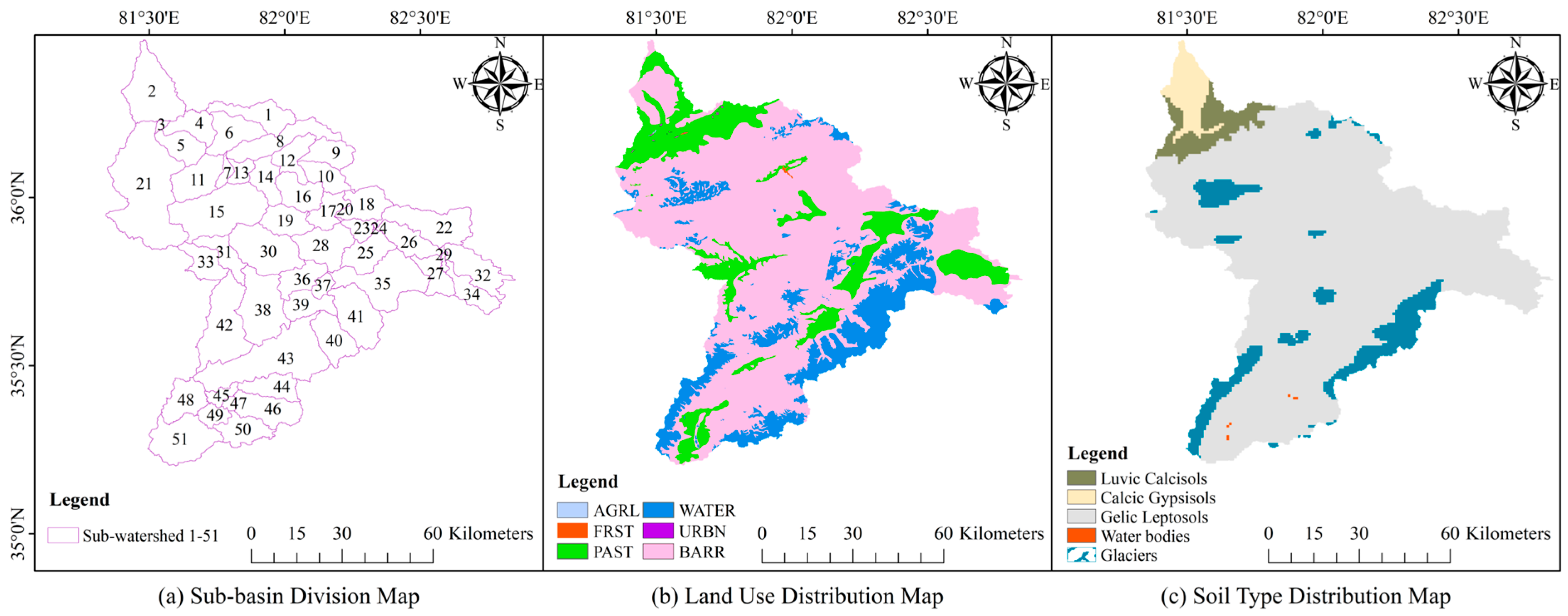
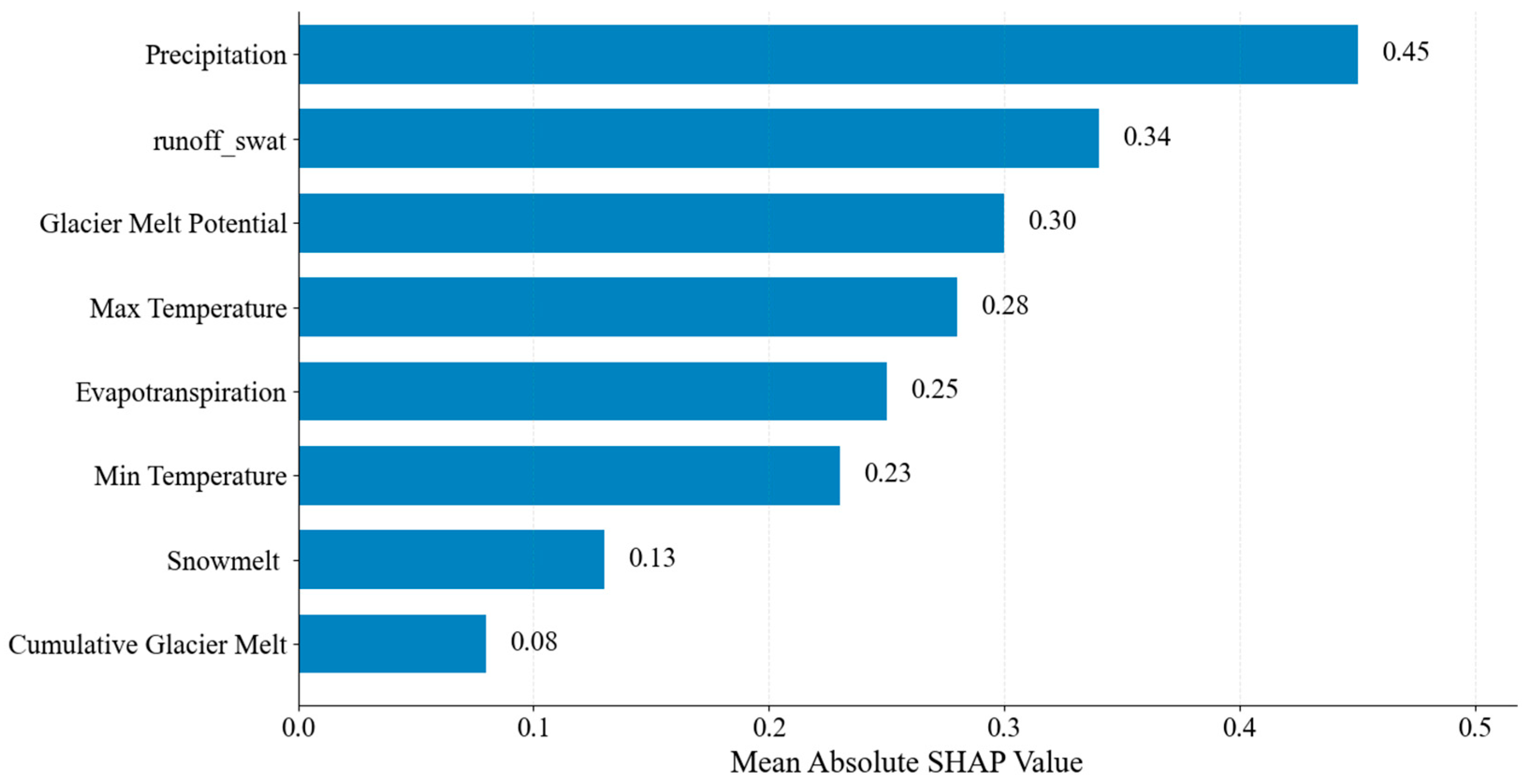

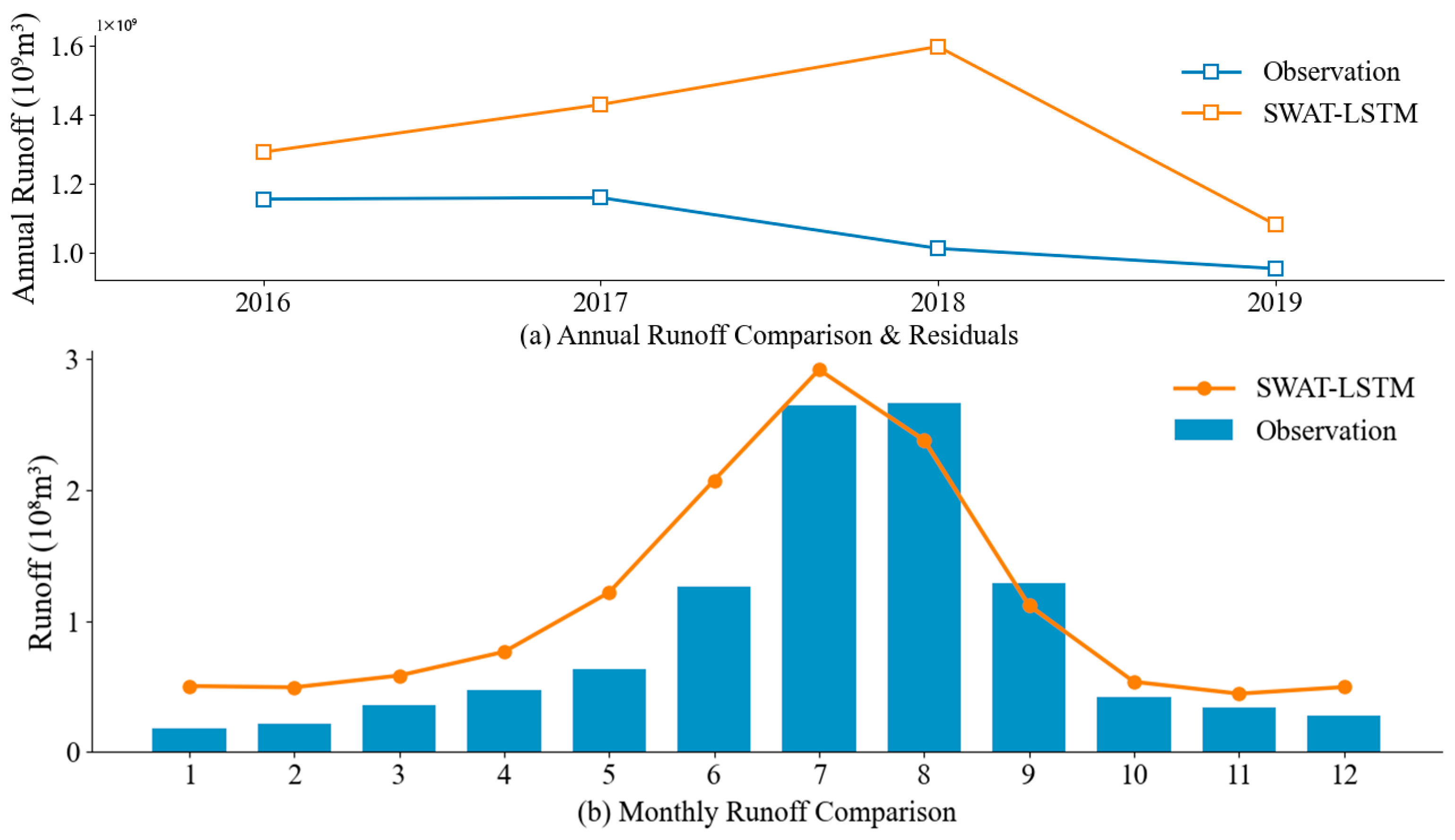
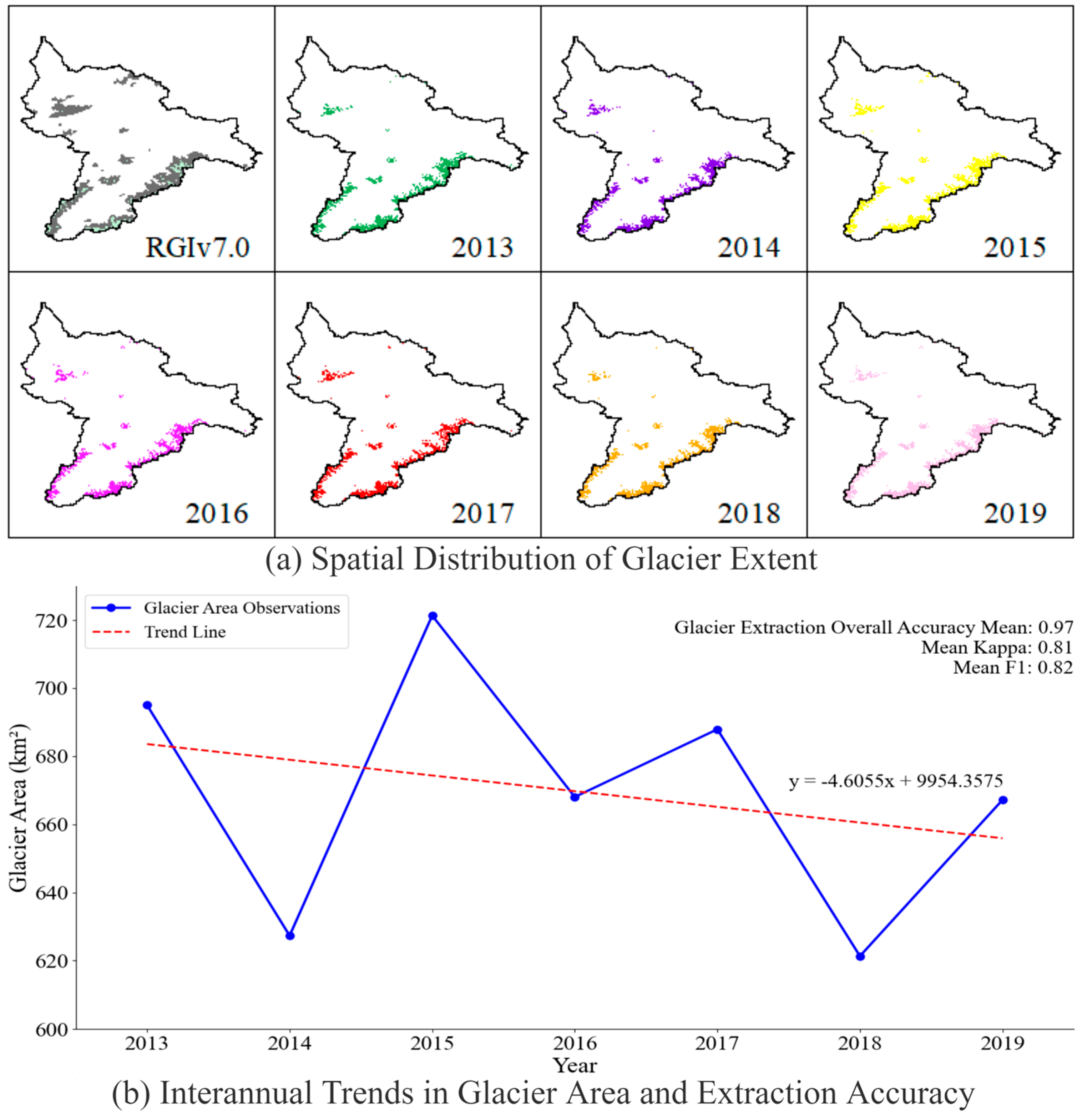



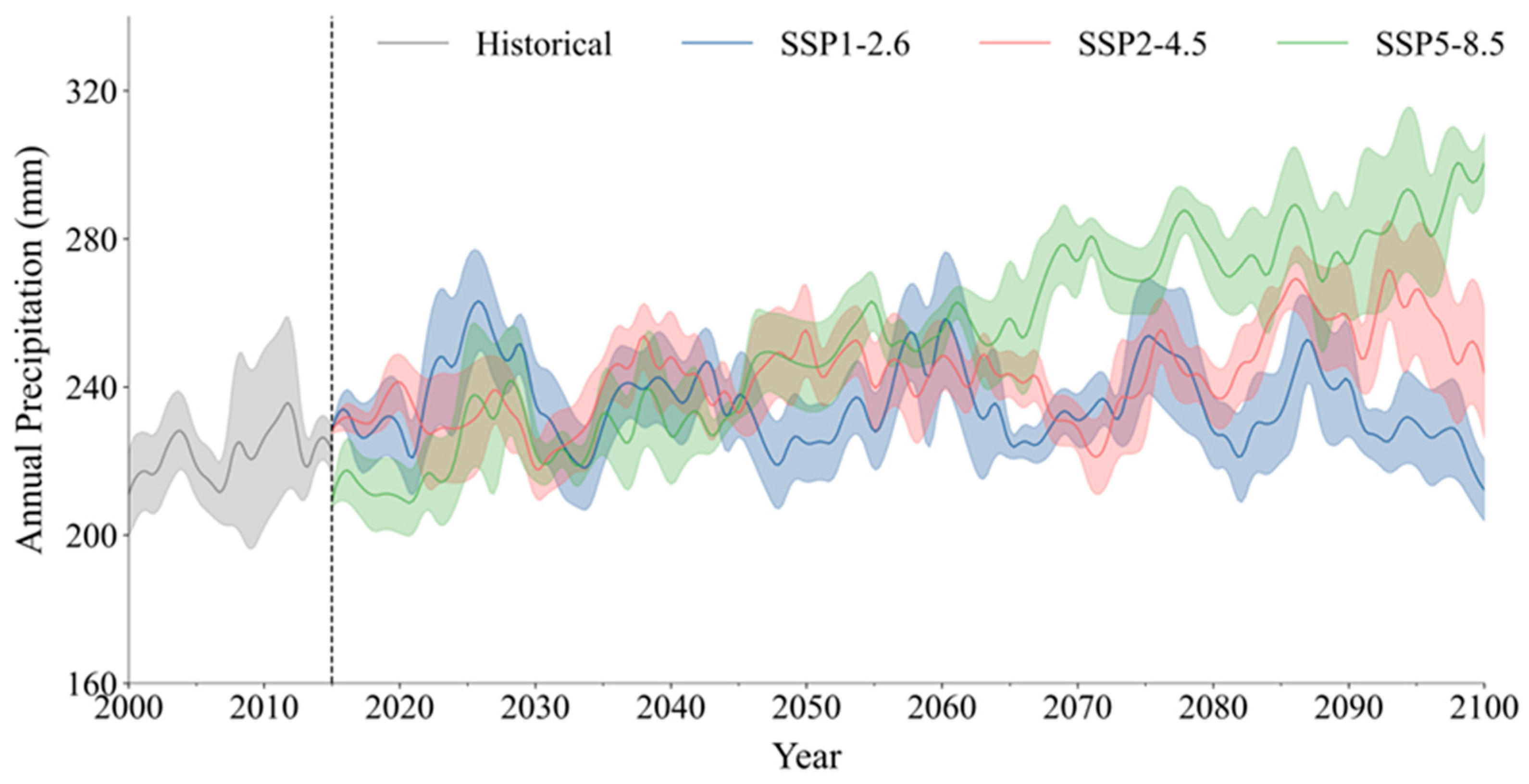
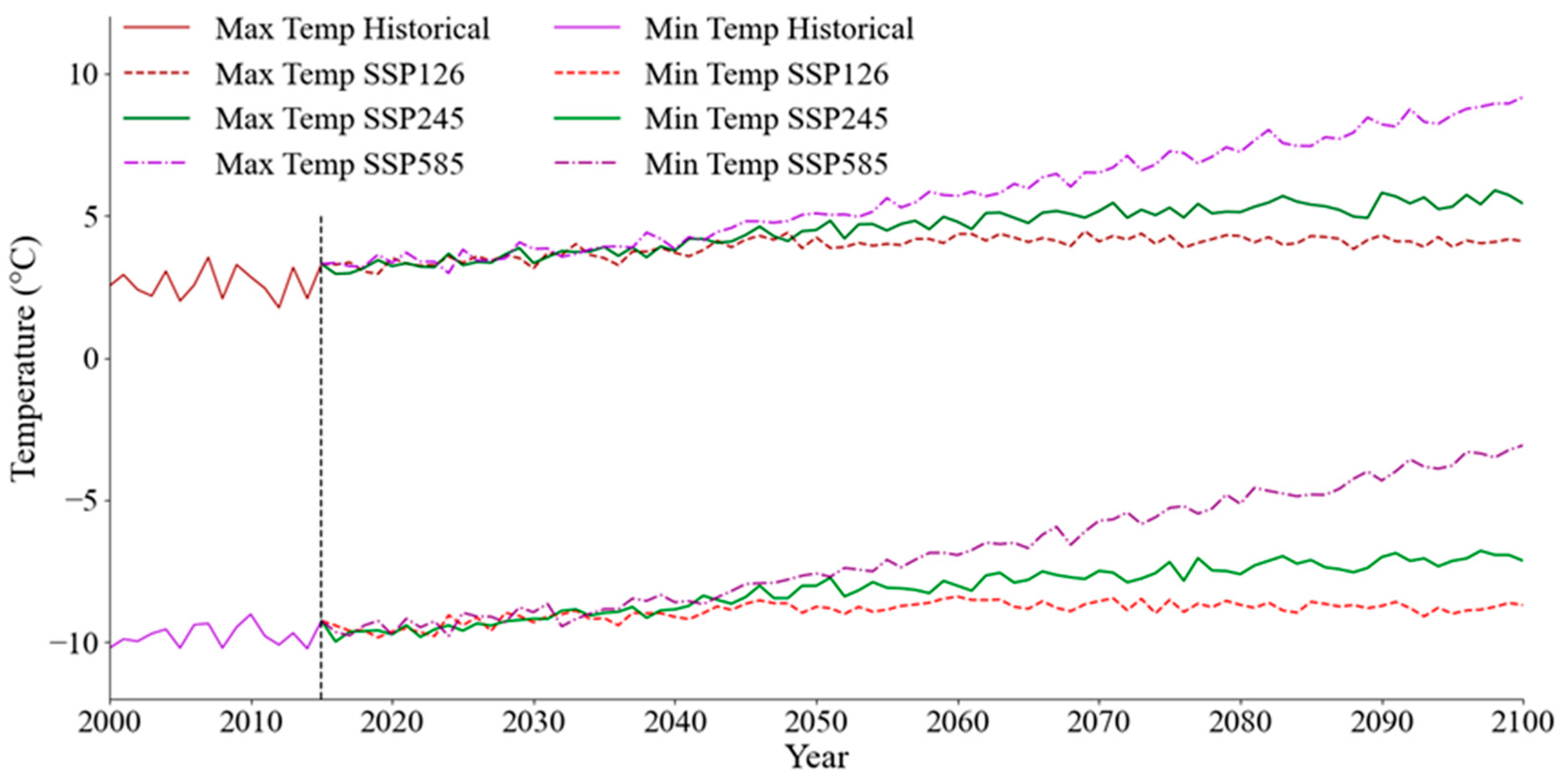


| Type | Content | Key Information |
|---|---|---|
| Spatial Data | DEM (30 m) | Geospatial Data Cloud (Generating River networks within basins and delineating sub-basins) |
| Land Use Data (30 m) | Resource Environment Science and Data Center (Hydrological Response Unit Delineation) | |
| Soil Data (1:1,000,000) | Spatio-Temporal Tripolar Environmental Big Data Platform (Soil Database Construction) | |
| Landsat8 (30 m) | Google Earth Engine Platform (Glacier Area Extraction) | |
| Meteorological and Hydrological Data | Historical Meteorological Data (Daily Values) | CN05.1 Dataset (Chinese Academy of Sciences Center for Climate Change Research) |
| Actual Runoff Data (Monthly Values) | Langan Hydrological Station (1961–2019) | |
| Future Weather Data (Daily Values) | CMIP6 Official Website | |
| Climate Model | 7 CMIP6 GCMs | See details 1 |
| Climate Scenario | SSP-1.26 (Low Coercivity) | A combination of low vulnerability, minimal mitigation pressure, and limited radiative forcing |
| SSP-2.45 (Medium Compulsion) | Combination of Moderate Societal Vulnerability and Moderate Anthropogenic Radiative Forcing | |
| SSP-5.85 (High-Force) | The only shared socio-economic pathway achieving the 2100 anthropogenic radiative forcing target |
| Parameter | Physical Meaning | Initial Range | Adjustment Method | Optimal Value | p | t |
|---|---|---|---|---|---|---|
| SMFMX | Maximum snowmelt rate (mm/°C/day) | 0~20 | v | 0.19 | 0.0000 | 11.6026 |
| CN2 | SCS runoff curve number | 35~98 | v | 80.3 | 0.0000 | 5.0549 |
| TIMP | Snow temperature lag coefficient | 0~1 | v | 0.9 | 0.1751 | −1.3612 |
| SURLAG | Surface runoff lag time coefficient (days) | 0.05~24 | v | 0.66 | 0.2509 | 1.1516 |
| ESCO | Soil evaporation compensation factor | 0~1 | v | 0.12 | 0.2881 | −1.0654 |
| ALPHA_BF | Baseflow recession coefficient | 0~1 | v | 0.88 | 0.3073 | −1.0238 |
| EPCO | Plant transpiration compensation factor | 0~1 | v | 0.83 | 0.3839 | 0.8727 |
| CAMMX | Maximum canopy interception capacity (mm) | 0~100 | v | 0.13 | 0.6171 | −0.5009 |
| GW_DELAY | Groundwater delay time (days) | 0~500 | v | 391.7 | 0.7665 | −0.2973 |
| BIOMIX | Biological mixing efficiency | 0~1 | r | 0.15 | 0.7739 | −0.2877 |
| SMFMN | Minimum snowmelt rate (mm/°C/day) | 0~20 | v | 0.037 | 0.8491 | −0.1904 |
| TLAPS | Temperature lapse rate (°C/km) | −10~10 | v | 4.14 | 0.8618 | 0.1742 |
| GW_REVAP | Groundwater revap coefficient | 0.02~0.2 | v | 0.024 | 0.8900 | 0.1384 |
| SMTMP | Base temperature for snowmelt (°C) | −20~20 | v | 1.57 | 0.9135 | 0.1088 |
| Model | The Calibration Period (1964–1999) | The Verification Period (2000–2015) | ||||||||
|---|---|---|---|---|---|---|---|---|---|---|
| NSE | R2 | PBIAS | RMSE (m3/s) | MAE (m3/s) | NSE | R2 | PBIAS | RMSE (m3/s) | MAE (m3/s) | |
| SWAT | 0.775 | 0.777 | 4.52% | 11.51 | 6.29 | 0.735 | 0.805 | 19.75% | 16.78 | 9.27 |
| SWAT-LSTM | 0.869 | 0.885 | 0.17% | 8.80 | 5.89 | 0.847 | 0.847 | 0.06% | 12.78 | 7.56 |
Disclaimer/Publisher’s Note: The statements, opinions and data contained in all publications are solely those of the individual author(s) and contributor(s) and not of MDPI and/or the editor(s). MDPI and/or the editor(s) disclaim responsibility for any injury to people or property resulting from any ideas, methods, instructions or products referred to in the content. |
© 2025 by the authors. Licensee MDPI, Basel, Switzerland. This article is an open access article distributed under the terms and conditions of the Creative Commons Attribution (CC BY) license (https://creativecommons.org/licenses/by/4.0/).
Share and Cite
Xing, K.; Yang, P.; Liu, S.; Zhao, Q. A Coupled SWAT-LSTM Approach for Climate-Driven Runoff Dynamics in a Snow- and Ice-Fed Arid Basin. Sustainability 2025, 17, 10235. https://doi.org/10.3390/su172210235
Xing K, Yang P, Liu S, Zhao Q. A Coupled SWAT-LSTM Approach for Climate-Driven Runoff Dynamics in a Snow- and Ice-Fed Arid Basin. Sustainability. 2025; 17(22):10235. https://doi.org/10.3390/su172210235
Chicago/Turabian StyleXing, Kun, Peng Yang, Sihai Liu, and Qinxin Zhao. 2025. "A Coupled SWAT-LSTM Approach for Climate-Driven Runoff Dynamics in a Snow- and Ice-Fed Arid Basin" Sustainability 17, no. 22: 10235. https://doi.org/10.3390/su172210235
APA StyleXing, K., Yang, P., Liu, S., & Zhao, Q. (2025). A Coupled SWAT-LSTM Approach for Climate-Driven Runoff Dynamics in a Snow- and Ice-Fed Arid Basin. Sustainability, 17(22), 10235. https://doi.org/10.3390/su172210235







